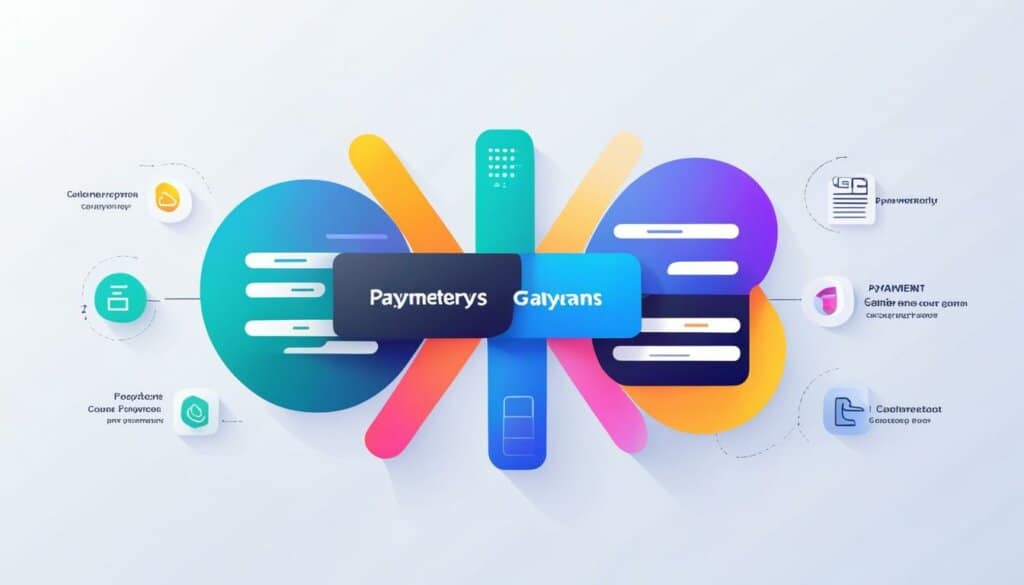Table of Contents
In an increasingly cashless world, where payment services are primarily performed digitally or through credit cards, a payment gateway can simplify and expedite payments to help both consumers and businesses. Payment gateways are a merchant service that processes credit card payments for both ecommerce sites and traditional brick-and-mortar stores. It is critical to understand how payment gateways work and what options are available when choosing a secure payment gateway.
How Do Payment Gateways Work?
A payment gateway acts as the central cog in the payment processing system, collecting, transferring, and authorizing customer information in real-time to a merchant’s bank. Whether you are making a purchase online or in-store, the payment gateway handles the transaction, ensuring secure and efficient processing of payments. It facilitates real-time transactions by securely transmitting customer payment data to the bank for authorization and settlement.
When a customer initiates a payment, the payment gateway encrypts the sensitive data, such as credit card details, to protect it from unauthorized access. It then securely transmits this encrypted data from the customer’s device to the payment processor, which forwards it to the acquiring bank. The acquiring bank verifies the legitimacy of the transaction and performs fraud checks. Once approved, the bank communicates the authorization status back to the payment gateway, which then informs the merchant and completes the transaction.
One of the key features of a payment gateway is its ability to process payments in real-time, providing immediate feedback to customers regarding the success or failure of their transactions. This real-time processing ensures promptness and accuracy, giving customers peace of mind and merchants the assurance that payments are being processed efficiently.
“A payment gateway is like the conductor of an orchestra, coordinating the flow of payment information between customers, merchants, and banks, ensuring harmonious and secure transactions.”
In addition to facilitating transactions, payment gateways also provide security measures to protect sensitive customer data. Secure Socket Layer (SSL) encryption is used to safeguard the transmission of payment information, making it virtually impossible for hackers to intercept and decipher the data. Payment gateways also implement various fraud prevention tools and compliance standards, such as Payment Card Industry Data Security Standard (PCI DSS), to maintain the integrity and security of payment transactions.
By acting as a reliable intermediary, payment gateways work seamlessly with merchant websites, mobile applications, and point-of-sale systems, enabling businesses to accept a wide range of payment methods, such as credit cards, debit cards, and digital wallets. They provide a convenient and secure payment experience for customers, facilitating smooth and hassle-free transactions.
| Benefits of Payment Gateways | Challenges of Payment Gateways |
|---|---|
|
|
Main Types of Payment Gateways
When it comes to online payments, businesses have several options for integrating payment gateways into their websites. Understanding the different types of payment gateways available can help you make an informed decision that aligns with your business needs. Here are the main types of payment gateways:
1. On-Site Payments
On-site payments refer to a payment gateway integration where the entire checkout process, including payment processing, is conducted on the merchant’s own servers. This type of integration provides a seamless user experience as customers remain on the merchant’s site throughout the entire payment process. This method gives merchants greater control over the checkout experience and allows for easy customization. However, it requires adherence to strict security protocols to ensure sensitive customer information is protected.
2. Checkout on Site
Checkout on site payment gateways involve the front-end checkout occurring on the merchant’s website, but the payment processing happens through the gateway’s back end. This type of integration offers a balance between control and convenience. Customers are directed to a secure payment page hosted by the payment gateway provider, ensuring the necessary security measures are in place. This option simplifies the integration process while maintaining a seamless user experience.
3. Redirects
Redirects involve taking customers to a different platform, such as PayPal, for payment processing. When customers choose this payment option, they are redirected to the chosen platform to complete the transaction. This method provides an additional layer of security, as sensitive payment information is handled by established and trusted third-party providers. However, redirects can introduce complexities in the checkout process, requiring customers to navigate away from the merchant’s site temporarily.
Each type of payment gateway has its advantages and limitations, and the choice depends on your specific business requirements. It’s crucial to consider factors like user experience, customization options, security, and integration ease when selecting the most suitable payment gateway for your e-commerce platform.

| Payment Gateway Type | Advantages | Limitations |
|---|---|---|
| On-Site Payments | Full control over the checkout process and user experience | Requires strict security measures to protect customer data on the merchant’s servers |
| Checkout on Site | Seamless integration with the website, maintaining a unified user experience | Reliance on the payment gateway’s back end for secure payment processing |
| Redirects | Enhanced security with established third-party payment processors | Potential disruption to the user experience during the redirection process |
Payment Gateways Limitations
When selecting a payment gateway for your business, it is crucial to understand its limitations. While payment gateways offer convenience, they also have certain restrictions that may impact your operations and customer experience.
Limited Card Acceptance
Not all payment gateways accept all types of cards or payment methods. It is important to ensure that the gateway you choose supports the specific payment methods your customers use. Failure to do so may result in declined transactions and inconvenience for your customers.
Challenges for International Shoppers
International shoppers may face limitations when using payment gateways. Some gateways may not support popular international payment options, limiting the payment choices available to these customers. Additionally, international transactions may incur higher fees, impacting the overall cost for your international shoppers.
Potential Security Flaws
While payment gateways have implemented security measures to protect customer data, there are still potential security flaws to consider. Data breaches and malware attacks can compromise the sensitive payment information of your customers, leading to significant reputational and financial damage for your business.
It is important to choose a payment gateway that takes security seriously and invests in robust security features to minimize the risk of security breaches. Conduct thorough research on the security measures implemented by the gateway provider to ensure the safety of your customers’ payment information.
Remember that trust and security are essential components of any successful online business. By choosing a payment gateway with strong security measures, you can give your customers peace of mind and enhance their overall shopping experience.
Despite these limitations, payment gateways remain a crucial tool for facilitating online transactions. By understanding their limitations and taking appropriate measures to mitigate risks, businesses can leverage payment gateways to provide secure and convenient payment options for their customers.
Choosing a Secure Payment Gateway
When it comes to selecting a payment gateway for your business, security should be a top priority. Ensuring the safety of customer payment information is crucial in establishing trust and protecting sensitive data. Here are some key factors to consider when choosing a secure payment gateway:
Customer Payment Preferences
Take into account your customers’ preferred payment methods and choose a gateway that can accommodate them. Whether it’s credit cards, digital wallets, or other alternative payment options, providing a range of choices will enhance the customer experience and increase conversion rates.
Integration with Existing Technology
Seamless integration with your existing technology platforms is essential for efficient payment processing. Look for a payment gateway that can seamlessly integrate with your e-commerce platform, point-of-sale system, or other software. This integration ensures a smooth flow of transactions and minimizes disruption to your operations.
Encryption and Security Measures
Verify that the payment gateway uses robust encryption technology to safeguard sensitive customer data during transmission. Look for a gateway that supports SSL (Secure Socket Layer) or TLS (Transport Layer Security) protocols to ensure secure data transmission. Additionally, ensure that the gateway is PCI-compliant, meeting the industry standards for handling credit card data securely.
Reputable Providers
Choose a payment gateway from a reputable provider with a proven track record in the industry. Well-known providers often have established security protocols and a reliable infrastructure in place to protect against potential vulnerabilities. Trustworthy providers inspire confidence in customers and contribute to the overall credibility of your business.
“Selecting a secure payment gateway is crucial in protecting customer payment information and maintaining their trust. By considering customer payment preferences, integration with existing technology, encryption and security measures, and partnering with reputable providers, you can ensure a robust and secure payment processing system for your business.”
By carefully evaluating the options available and selecting a secure payment gateway that aligns with these considerations, businesses can instill confidence in their customers and protect sensitive payment information. Prioritizing security not only helps businesses comply with industry standards but also enhances the overall customer experience.
| Considerations | Features |
|---|---|
| Customer Payment Preferences | Accommodate various payment methods |
| Integration with Existing Technology | Seamless integration with e-commerce platforms, point-of-sale systems, etc. |
| Encryption and Security Measures | Secure data transmission and PCI compliance |
| Reputable Providers | Choose from established and trustworthy providers |
Choosing a secure payment gateway is a critical step in establishing a robust and protected online payment system. By prioritizing security and aligning with customer preferences, businesses can create a seamless and secure payment experience for their customers.

Conclusion
Secure online payment solutions are imperative for businesses operating in the digital landscape. By understanding the intricacies of payment gateways, the different types available, their limitations, and the key factors to consider when choosing a secure payment gateway, businesses can ensure seamless and secure online transactions for their customers. The right payment gateway is essential for fostering trust, meeting customer preferences, and safeguarding sensitive payment information.
In today’s cashless society, payment gateways serve as a vital link between merchants and customers, streamlining the payment process and providing a secure environment for transactions. Businesses must prioritize security when selecting a payment gateway, ensuring it aligns with their customers’ preferred payment methods. Integration with existing technology is also crucial for efficient operations and a seamless customer experience.
When evaluating payment gateway options, it is important to look for providers that employ robust encryption technology and adhere to Payment Card Industry Data Security Standard (PCI-DSS) compliance. Opting for reputable payment gateway providers not only instills confidence in customers but also mitigates the risks associated with security breaches and cyber attacks.
Ultimately, the choice of a secure payment gateway is pivotal for businesses seeking to thrive in the digital marketplace. By investing time and effort in understanding the functioning of payment gateways, evaluating available options, and prioritizing security, businesses can establish a strong foundation for online transactions, gain customer trust, and foster growth in the highly competitive e-commerce landscape.
FAQ
How do payment gateways work?
Payment gateways act as the central cog in the payment processing system, handling the secure collection, transfer, and authorization of customer information in real-time to a merchant’s bank.
What are the main types of payment gateways?
There are generally three types of payment gateways: on-site payments, checkout on site, and redirects. On-site payments handle the checkout experience and payment processing on the merchant’s servers. Checkout on site involves front-end checkout on the merchant’s site, with payment processing happening through the gateway’s back end. Redirects take customers to a different platform, such as PayPal, for payment processing.
What are the limitations of payment gateways?
Payment gateways may have limitations in terms of accepted cards/payments, international payment options, and transaction fees. Additionally, there are potential security flaws to consider, such as data breaches and malware attacks.
How do I choose a secure payment gateway?
When choosing a secure payment gateway, consider your customers’ preferred payment methods and ensure the gateway supports them. Integration with your existing technology platforms is crucial for seamless operations. Look for a payment gateway that uses secure encryption technology and is PCI-compliant. It is also important to consider the reputation of the payment gateway provider.







